ECU PONTIAC PONTIAC 1997 Owners Manual
[x] Cancel search | Manufacturer: PONTIAC, Model Year: 1997, Model line: PONTIAC, Model: PONTIAC PONTIAC 1997Pages: 419, PDF Size: 19.67 MB
Page 23 of 419
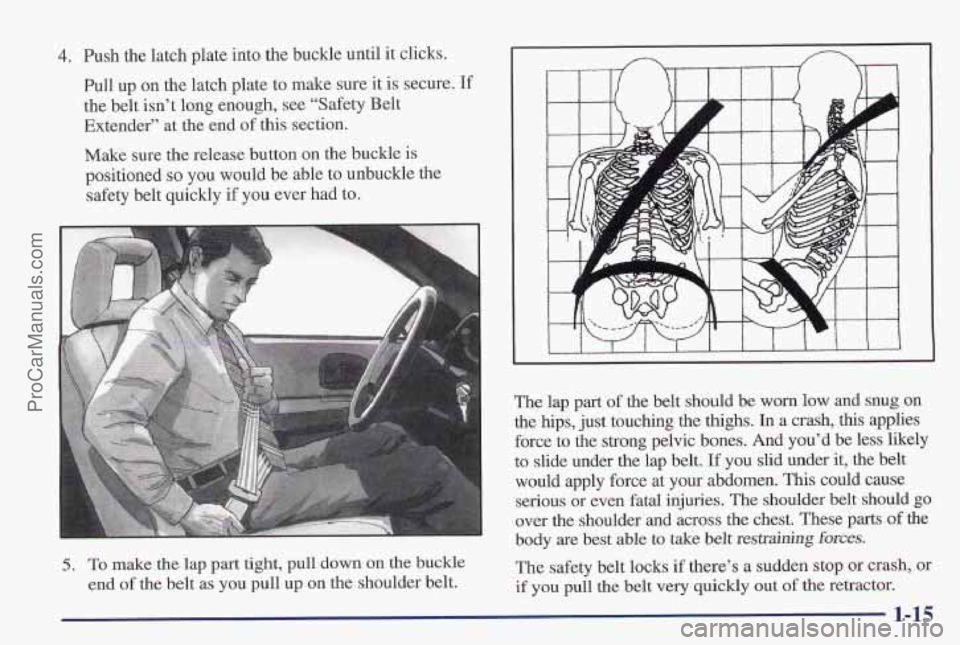
4. Push the latch plate into the buckle until it clicks.
Pull up on the latch plate to make sure it is secure.
If
the belt isn’t long enough, see “Safety Belt
Extender” at the end
of this section.
Make sure the release button on the buckle is
positioned
so you would be able to unbuckle the
safety belt quickly if you ever had to.
-4
5. To make the lap part tight, pull down on the buckle
end
of the belt as you pull up on the shoulder belt. The
lap part
of the belt should be worn low and snug on
the hips, just touching the thighs. In a crash, this applies
force to the strong pelvic bones. And you’d be less likely
to slide under
the lap belt. If you slid under it, the belt
would apply force at your abdomen. This could cause
serious
or even fatal injuries. The shoulder belt should go
over the shoulder and across the chest. These parts of the
body are best able to take belt restraining
foxes.
The safety belt locks if there’s a sudden stop or crash, or
if you pull the belt very quickly out of the retractor.
1-15
ProCarManuals.com
Page 31 of 419
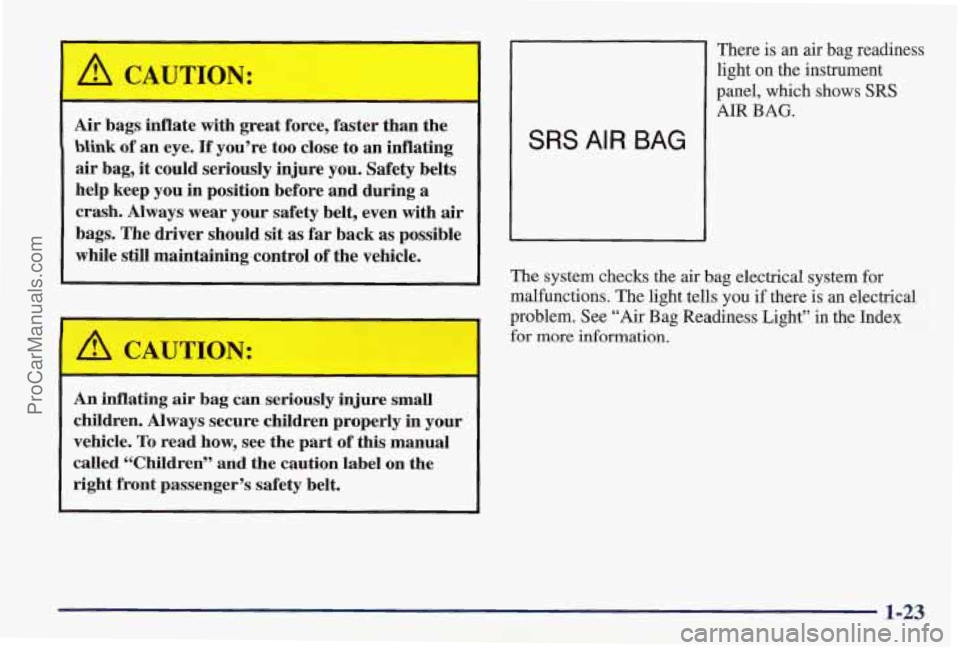
I A CAUTION:
Air bags inflate with great force, faster than the
blink of an eye. If you’re too close to an inflating
air bag,
it could seriously injure you. Safety belts
help keep you in position before and during a
crash. Always wear your safety belt, even with
air
bags. The driver should sit as far back as possible
while still maintaining control
of the vehicle.
SRS AIR BAG
There is an air bag readiness
light on the instrument
panel, which shows SRS
AIR BAG.
An inflating air bag can seriously injure small
children. Always secure children properly in your
vehicle.
To read how, see the part of this manual
called Whildren” and the caution label on the
right front passenger’s safety belt.
The system checks the air bag electrical system for
malfunctions. The light tells
you if there is an electrical
problem. See “Air Bag Readiness Light” in
the Index
I for more information.
1-23
ProCarManuals.com
Page 38 of 419
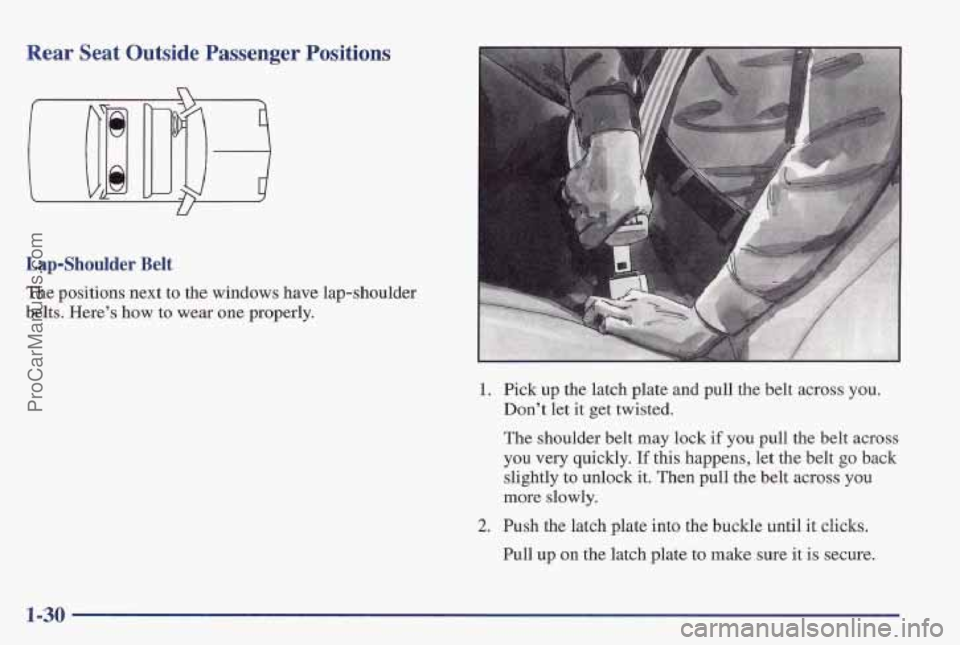
Rear Seat Outside Passenger Positions
Lap-Shoulder Belt
The positions next to the windows have lap-shoulder
belts. Here’s how
to wear one properly.
1. Pick up the latch plate and pull the belt across you. Don’t let
it get twisted.
The shoulder belt may lock if you pull the belt across
you very quickly.
If this happens, let the belt go back
slightly
to unlock it. Then pull the belt across you
more slowly.
2. Push the latch plate into the buckle until it clicks.
Pull
up on the latch plate to make sure it is secure.
1-30
ProCarManuals.com
Page 45 of 419
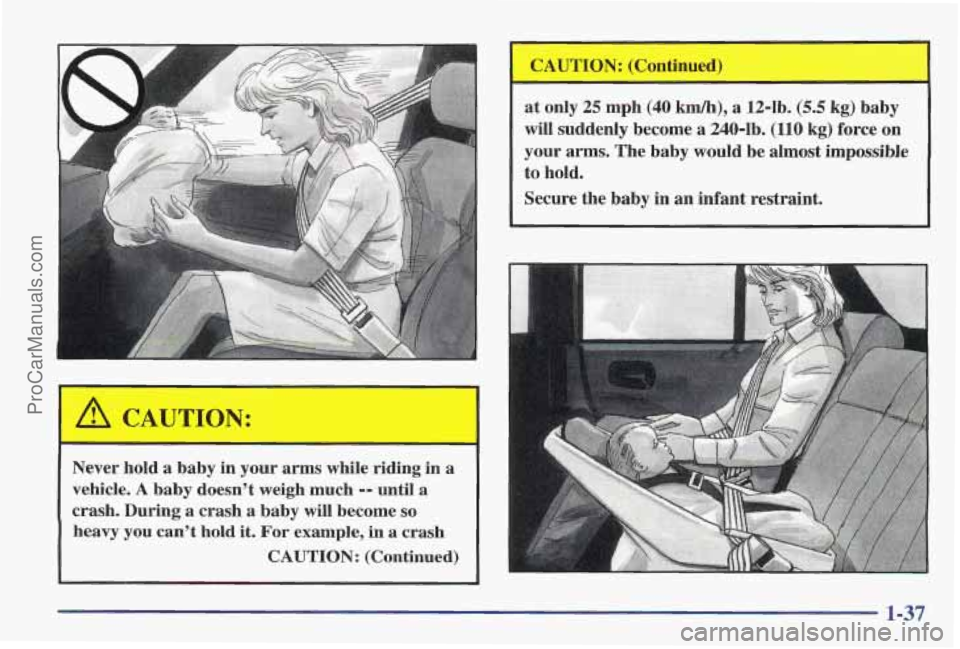
A CAUTION:
Never hold a baby in your arms while riding in a
vehicle.
A baby doesn’t weigh much -- until a
crash. During a crash a baby will become
so
heavy you can’t hold it. For example, in a crash
CAUTION: (Continued)
I
CAUTION: (Continued)
at only
25 mph (40 km/h), a 12-lb. (5.5 kg) baby
will suddenly become
a 240-lb. (110 kg) force on
your arms. The baby would be almost impossible
to hold.
Secure the baby in an infant restraint.
1-37
ProCarManuals.com
Page 52 of 419

12. Move the pad back against the child restraint
seatback.
Make sure the harness goes through the
slots in the pad that match the height adjustment
slots being used.
fastener
strip.
13, Press the upper edge of the pad against the
Securing a Child in the Built-in Child Restraint
-
Now that the harness is adjusted to the correct height for
your child, you’re ready to use the child restraint’s
harness (E) to secure your child.
Don’t use the vehicle’s safety belts.
Using the vehicle’s regular safety belts on a child
seated on the child restraint cushion can cause
serious injury
to the child in a sudden stop or
cra,sh.
If a child is the proper size for the built-in
child restraint, secure the child using the child
restraint’s harness. But children
who are too
large for the built-in child restraint should sit on
the vehicle’s regular seat and use the regular
safety belts.
WARNING! FAILURE TO FOLLOW THE
MANUFACTURER’S INSTRUCTIONS ON THE
USE OF THIS CHILD RESTRAINT SYSTEM
CAN RESULT IN YOUR CHILD STRIKING
THE
VEHICLE’S INTERIOR DURING A SUDDEN STOP
OR CRASH.
SNUGLY ADJUST
THE BELTS PROVIDED WITH
THIS CHILD RESTRAINT AROUND YOUR CHILD.
ProCarManuals.com
Page 55 of 419
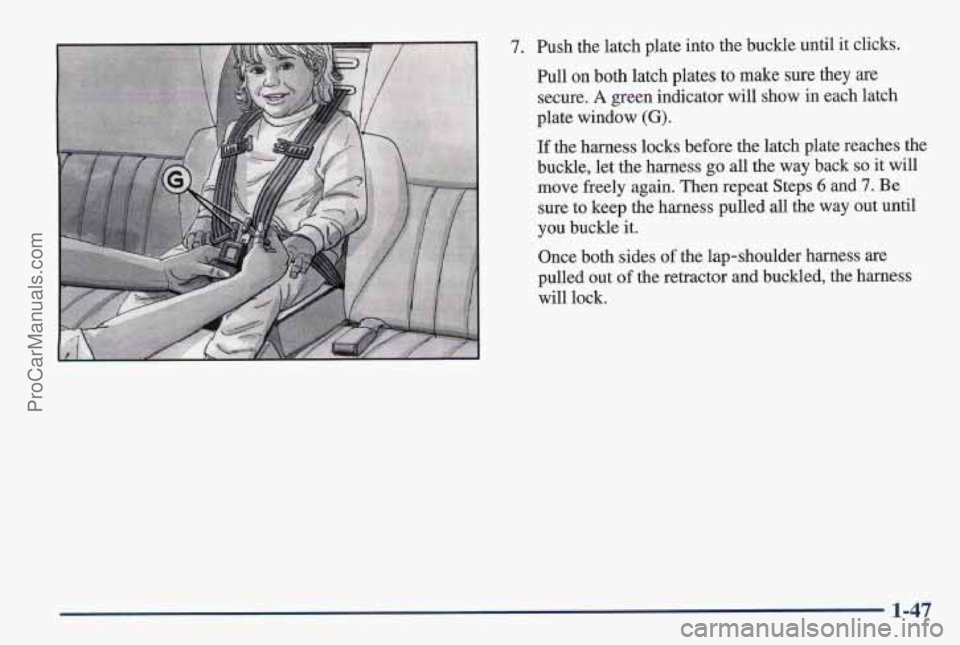
7. Push the latch plate into the buckle until it clicks.
Pull on both latch plates to make sure they are
secure.
A green indicator will show in each latch
plate window
(G).
If the harness locks before the latch plate reaches the
buckle, let the harness
go all the way back so it will
move freely again. Then repeat Steps
6 and 7. Be
sure to keep the harness pulled all the way out until
you buckle it.
Once both sides of the lap-shoulder harness are
pulled out
of the retractor and buckled, the harness
will lock.
1-47
ProCarManuals.com
Page 59 of 419
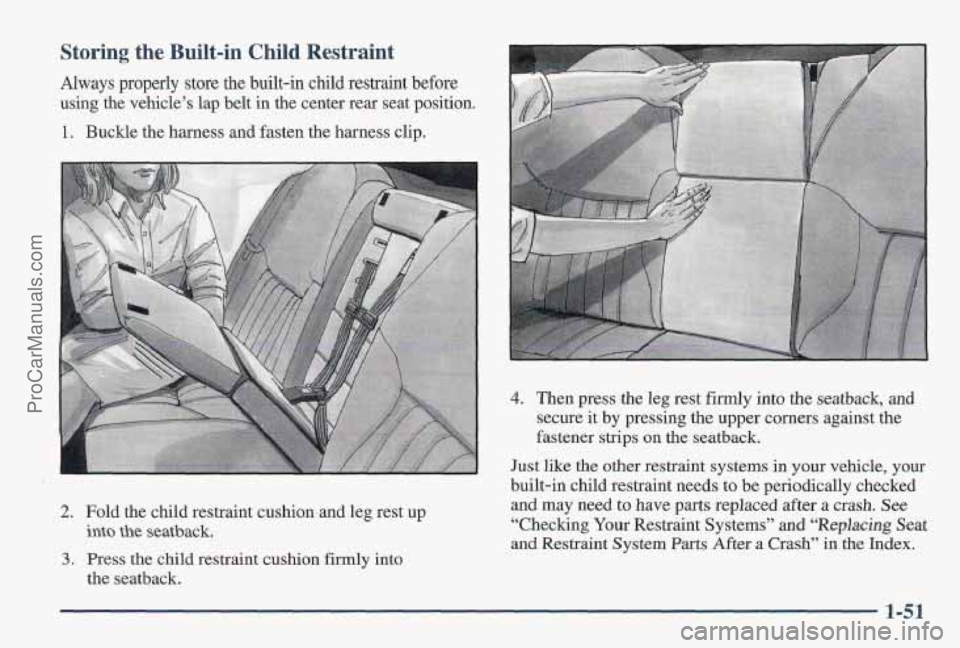
Storing the Built-in Child Restraint
Always properly store the built-in child restraint before
using the vehicle’s lap belt in the center rear seat position.
1. Buckle
the harness and fasten the harness clip.
2. Fold the child restraint cushion and leg rest up
into the seatback.
3. Press the child restraint cushion firmly into
the seatback.
4. Then press the leg rest firmly into the seatback, and
secure it by pressing the upper corners against the
fastener strips
on the seatback.
Just like the other restraint systems in your vehicle, your
built-in child restraint needs
to be periodically checked
and may need
to have parts replaced after a crash. See
“Checking Your Restraint Systems” and “Replacing Seat
and Restraint System Parts After a Crash” in the Index.
1-51
ProCarManuals.com
Page 60 of 419
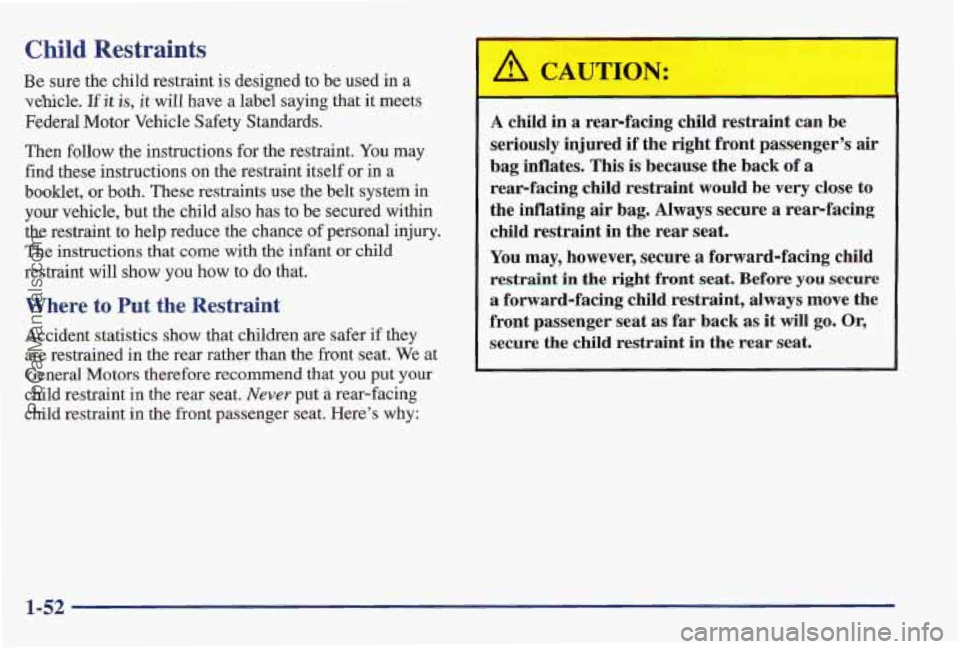
Child Restraints
Be sure the child restraint is designeld to be used in a
vehicle.
If it is, it will have a label saying that it meets
Federal Motor Vehicle Safety Standards.
Then
follow the instructions for the restraint. You may
find these instructions on the restraint itself or in a
booklet, or both. These restraints use the belt system in
your vehicle, but the child
also has to be secured within
the restraint to help reduce the chance
of personal injury,
The instructions that come with the infant or child
restraint will
show you how to dol that.
Where to Put the Restraint
Accident statistics show that children are safer if they
are restrained in the rear rather than the front
seat. We at
General Motors therefore recommen'd that
you put your
child restraint in the rear seat.
Never gut a rear-facing
child restraint in the front passenger seat. Here's
why:
A child in a rear-facing child restraint can be
seriously injured
if the right front passenger's air
bag inflates. This is because the
back of a
rear-facing child restraint would be very close to
the inflating air bag. Always secure
a rear-facing
child restraint
in the rear seat.
You may, however, secure a forward-facing child
restraint in the right front seat. Before you secure
a forward-facing child restraint, always move the
front passenger seat as far back as it will
go. Or,
secure the child restraint in the rear seat.
1-52
ProCarManuals.com
Page 61 of 419
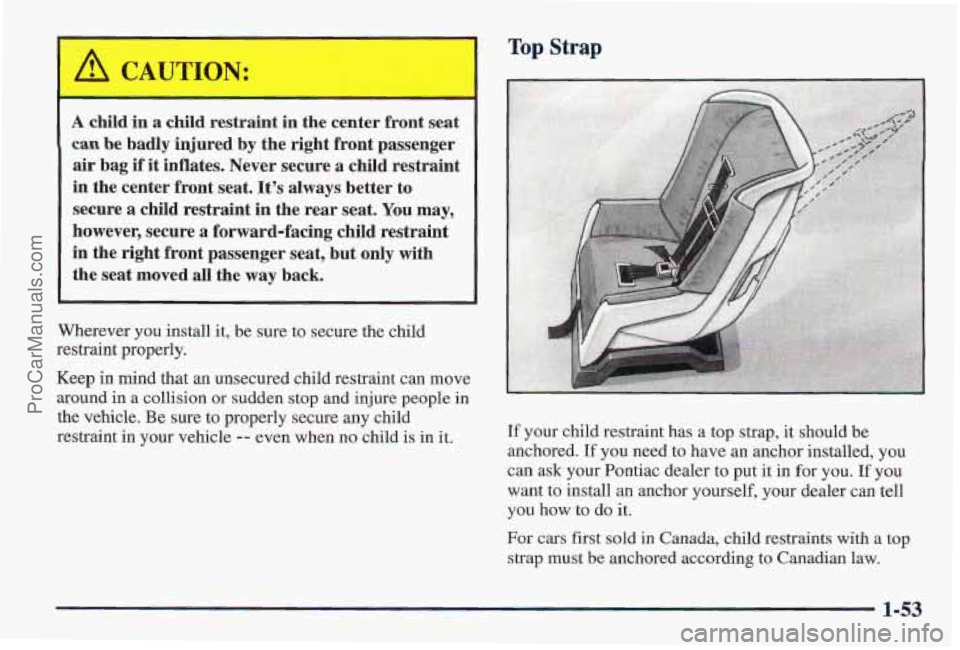
A child in a child restraint in the center front seat
can be badly injured by the right front passenger
air bag
if it inflates. Never secure a child restraint
in the center front seat.
It’s always better to
secure a child restraint in the rear seat. You may,
however, secure a forward-facing child restraint
in the right front passenger seat, but only
with
th’e seat moved all the way back.
Wherever you install it, be sure to secure the child
restraint properly.
Keep in mind that an unsecured child restraint can move
around in a collision or sudden stop and injure people in
the vehicle. Be sure to properly secure any child
restraint in your vehicle
-- even when no child is in it.
Top Strap
I
If your child restraint has a top strap, it should be
anchored. If you need to have an anchor installed, you
can ask your Pontiac dealer to put it in for you.
If you
want to install an anchor yourself, your dealer can tell
you how to
do it.
For cars first sold in Canada, child restraints with a top
strap must be anchored according to Canadian law.
1-53
ProCarManuals.com
Page 62 of 419
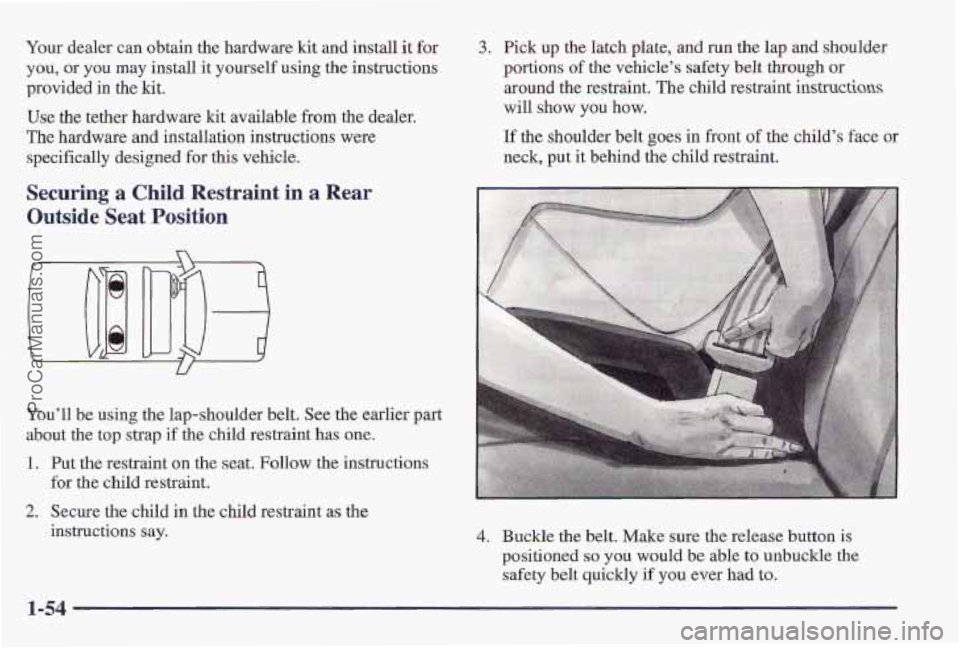
Your dealer can obtain the hardware kit and install it for
you, or
you may install it yourself using the instructions
provi’ded in
the kit.
Use the tether hardware kit available from the dealer.
The hardware and installation instructions were
specifically designed
for this vehicle.
Securing a Child Restraint in a Rear
Outside Seat
Position
You’ll be using the lap-shoulder belt. See the earlier part
about the top strap if the child restraint has
one.
1. Put the restraint on the seat. Follow the instructions
2. Secure the child in the child restraint as the
for the child restraint.
instructions
say.
3. Pick up the latch plate, and run the lap and shoulder
portions of the vehicle’s safety belt through or
around the restraint. The child restraint instructions
will show you how.
If the shoulder belt goes in front of the child’s face or
neck, put it behind
the child restraint.
4. Buckle the belt. Make sure the release button is
positioned so you would be able to unbuckle the
safety belt quickly
if you ever had to.
ProCarManuals.com